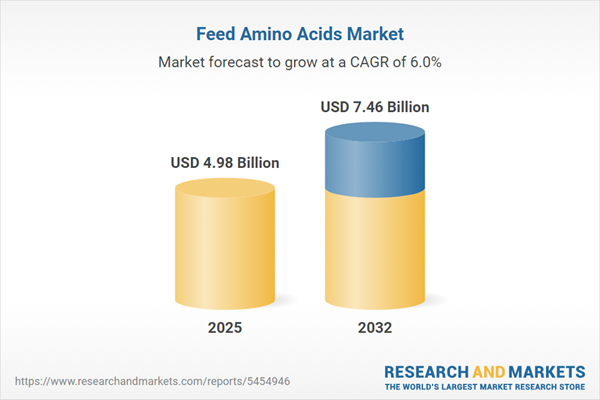Speak directly to the analyst to clarify any post sales queries you may have.
Senior leaders operate in a dynamic feed amino acids market shaped by ongoing regulatory constraints, innovations in production, and a global mandate for sustainable animal nutrition. Real-time intelligence and strategic flexibility are essential to maintain a competitive position and support long-term organizational strength.
Market Snapshot: Feed Amino Acids Market
The global feed amino acids market is projected to reach USD 4.70 billion in 2024, growing steadily through 2025 and continuing into 2032. This expansion is driven by demand for premium animal proteins and continued integration of advanced technologies in feed formulation and processing. Modern supply chain adaptations focus on enhancing production resilience, compliance with environmental requirements, and alignment with international industry benchmarks. Senior executives implementing timely market intelligence and agile operational tactics position their organizations for measurable value and improved sector standing.
Scope & Segmentation of the Feed Amino Acids Market
- Amino Acid Types: Lysine, methionine, threonine, and tryptophan are central to optimizing animal health in livestock, aquaculture, and companion animal nutrition. These essential amino acids enable producers to meet diverse efficiency and sustainability targets.
- Production Methods: Technologies include extraction, fermentation-driven manufacturing, and chemical synthesis. The sector favors methods that ensure cost control, reliability, compliance, and the adaptability needed for optimizing regional supply chains.
- Product Forms: Both solid crystalline and liquid feed amino acid formulations are utilized to support varying program specifications and operational models, accommodating the dynamic needs of the animal nutrition industry.
- Application Areas: Solutions are tailored to aquaculture, pet food, poultry, ruminant, and swine sectors, each addressing species-specific nutritional requirements, health outcomes, and stakeholder objectives.
- Regions Covered: The market encompasses the Americas, Europe, Middle East & Africa, and Asia-Pacific. Each region presents a distinct regulatory landscape, differing sustainability adoption rates, and unique market maturity, guiding targeted investment and supply strategies.
- Top Companies Profiled: Industry leaders include Evonik Industries AG, Adisseo France SAS, Novus International, Archer-Daniels-Midland Company, and Cargill, Incorporated. These firms set standards through regulatory adherence and alignment of sustainability commitments with operational practices.
Key Takeaways for Senior Decision-Makers
- Proactive adaptation to regulatory evolution and investment in sustainability initiatives set companies apart, strengthening animal protein value chains.
- Ongoing optimization of feed amino acid blends promotes productivity while supporting industry-driven and environmental goals.
- Advanced fermentation and synthetic production processes ensure reliable output and readiness for emerging global regulations.
- The integration of real-time analytics and digitized supply chain management improves responsive quality control and risk assessment.
- Partnerships with suppliers, research institutions, and technical experts diversify innovation capabilities while reducing operational vulnerabilities.
- Implementation of digital feed formulation and benchmarking platforms secures productivity gains and raises operational standards across the sector.
Tariff Impact: Navigating Policy and Supply Chain Adjustments
Recent changes to US tariffs have created new challenges in the feed amino acid supply chain, adding complexity to global import and export flows. To ensure continuous supply in this shifting environment, companies are focusing on improved procurement practices, enhanced logistics, and building resilient supplier partnerships. The adoption of advanced monitoring and adaptive inventory management tools is critical for reducing policy-related risks and maintaining reliable delivery as market conditions evolve.
Methodology & Data Sources
This research combines extensive secondary analysis with direct input from industry participants, suppliers, and regulatory authorities. Scenario modeling and data validation underpin the credibility of risk insights and action-oriented recommendations for stakeholders active in the feed amino acids space.
Why This Report Matters
- Enables senior executives to benchmark operations and proactively identify strategic opportunities and risks within the feed amino acids market.
- Provides comprehensive evaluations of key growth drivers, technical advances, and shifting regional market conditions to support informed planning and investment decisions.
- Presents frameworks to enhance risk management, supply chain adaptability, and operational preparedness as the industry continues to evolve.
Conclusion
Staying competitive requires a focus on sustainability and further development of production processes. By prioritizing adaptability and continuous improvement, leaders are well positioned for long-term market success.
Additional Product Information:
- Purchase of this report includes 1 year online access with quarterly updates.
- This report can be updated on request. Please contact our Customer Experience team using the Ask a Question widget on our website.
Table of Contents
3. Executive Summary
4. Market Overview
7. Cumulative Impact of Artificial Intelligence 2025
Companies Mentioned
The companies profiled in this Feed Amino Acids market report include:- Evonik Industries AG
- Adisseo France SAS
- Novus International, Inc.
- Archer-Daniels-Midland Company
- Cargill, Incorporated
- BASF SE
- Ajinomoto Co., Inc.
- Meihua Group Co., Ltd.
- CJ CheilJedang Corporation
- Kyowa Hakko Bio Co., Ltd.
Table Information
| Report Attribute | Details |
|---|---|
| No. of Pages | 185 |
| Published | November 2025 |
| Forecast Period | 2025 - 2032 |
| Estimated Market Value ( USD | $ 4.98 Billion |
| Forecasted Market Value ( USD | $ 7.46 Billion |
| Compound Annual Growth Rate | 5.9% |
| Regions Covered | Global |
| No. of Companies Mentioned | 11 |









